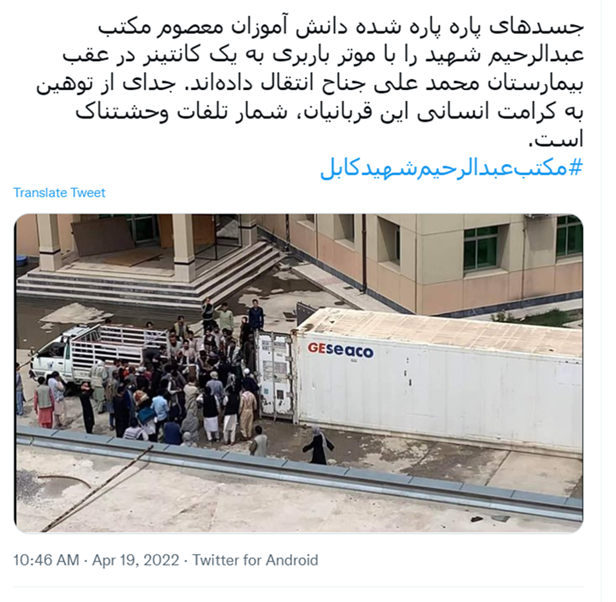On the morning of April 19, a series of explosions took place in two separate locations in Dasht-e-Barchi, PD13, west Kabul. In both attacks, boys’ schools were targeted. The Dasht-e-Barchi area of Kabul has a predominantly Hazara Shia population.
The first reports surfaced at around 0930 local time, stating that an explosion occurred near the Al Mumtaz Language Academy in Dasht-e-Barchi, Kabul. The news agency Subhe Kabul reported that the explosion was caused by a hand grenade.
Reports of a second explosion near the Abdul Rahim Shahid School in Dasht-e-Barchi emerged at around 1020. Shortly after, it was reported that the school had been hit by at least two consecutive explosions. According to a student that was allegedly interviewed by Irib News Agency, armed assailants had stormed the school.
While initial reports suggested pupils and staff at Abdul Rahim Shahid school may have been targeted by suicide bombers, Kabul police spokesman Khalid Zadran said improvised explosive devices had been left outside the school.
A teacher at the school reportedly told the news agency Etilatrooz that the first explosion detonated while children were exiting the school, and the second explosion happened as bystanders tried to move victims away from the first blast site.
At the time of writing, the explosions are yet to be claimed, though Dasht-e-Barchi has been frequently targeted by Islamic State (IS) in the past due to its large Hazara Shia population. Hazaras are an ethnic and religious minority in Afghanistan, and viewed as heretics by Sunni militant groups.
Afghan Witness (AW) investigators were able to verify footage from the aftermath of the explosions:
 Figure 1: geolocation of Abdul Rahim Shahid High School, coordinates: 34.496290, 69.075623
Figure 1: geolocation of Abdul Rahim Shahid High School, coordinates: 34.496290, 69.075623
 Figure 2: geolocation of aftermath of explosion at Abdul Rahim Shahid High School, coordinates: 34.495595, 69.077566
Figure 2: geolocation of aftermath of explosion at Abdul Rahim Shahid High School, coordinates: 34.495595, 69.077566
Reports on the total number of casualties are inconclusive and difficult to distinguish across the multiple locations.
At 1039 local time, shortly after initial reports surfaced about the first and second explosion, Al-Mayadeen news agency reported that at least six people were killed, without mentioning the locations of the casualties. The former director for the state-run news agency Bakhtar News reported that one student was critically injured, while six others sustained superficial injuries at the Al-Mumtaz Language Academy. Multiple other sources reported that eyewitnesses counted between 20 and 30 casualties.
At 1218 local time, Spokesperson for the Kabul Police Office, Khalid Zadran, reiterated reports that six people were killed at the Abdul Rahim Shahid High School, adding that 11 people were also injured. Despite these official numbers, AW investigators were able to identify at least eight bodies in verified footage from the Abdul Rahim Shahid High School explosion. Unfortunately, AW investigators were not able to find footage from the Al-Mumtaz Language Academy, or determine the total number of casualties at this site.
Shortly after the first explosions, reports surfaced that the Taliban did not allow journalists to cover the incidents, and that several reporters were harassed and had their cameras taken away. Ali Reza Shaheer, a reporter for the Rah-e-Farda TV news agency, was allegedly detained and beaten by Taliban forces as he tried to cover the explosions and interview eyewitnesses.
Throughout the course of the day, an increasing number of reports emerged suggesting that the Taliban were actively obstructing civilian support and response to the incidents. Following the attacks, victims and family members headed towards the Mohammed Ali Jinnah Hospital in Dasht-e-Barchi. Footage from this vicinity shows Taliban fighters appearing to aggressively bar civilians – who were allegedly in search of relatives and acquaintances – from entering the hospital.
 Figure 3: geolocation of footage claiming to show Taliban forces denying people entry to the Mohammed Jinnah Hospital, coordinates: 34.503372, 69.100061
Figure 3: geolocation of footage claiming to show Taliban forces denying people entry to the Mohammed Jinnah Hospital, coordinates: 34.503372, 69.100061
Other witnesses at the hospital reported that the Taliban did not allow civilians to donate blood for the victims. In a video response, one woman claimed that she had been assaulted by the Taliban after trying to find people she knew and attempting to donate blood. While AW was able to geolocate several videos from outside the hospital, we cannot verify these claims.
 Figure 4: geolocation of video wherein a woman states that Taliban fighters won’t let people donate blood at the Mohammed Jinnah Hospital, coordinates: 34.503317, 69.100006
Figure 4: geolocation of video wherein a woman states that Taliban fighters won’t let people donate blood at the Mohammed Jinnah Hospital, coordinates: 34.503317, 69.100006
Several sources, including a journalist from 1TV Afghanistan, stated that the Taliban transferred the bodies and remnants of the victims of the explosions to the Mohammed Ali Jinnah hospital in a large truck, after which they were allegedly dumped in a container. AW investigators were able to geolocate the image, however could not verify the claims made.
 Figure 5: Tweet from 1TV Journalist stating the Taliban transferred bodies of the victims in a large truck, after which they were allegedly dumped in a container. AW has geolocated the image, but cannot verify whether this claim is true.
Figure 5: Tweet from 1TV Journalist stating the Taliban transferred bodies of the victims in a large truck, after which they were allegedly dumped in a container. AW has geolocated the image, but cannot verify whether this claim is true.
The attacks have drawn condemnation from the international community, and come nearly a year after more than 90 students and staff were killed in an attack by IS on a girls’ school in Dasht-e-Barchi last May.


